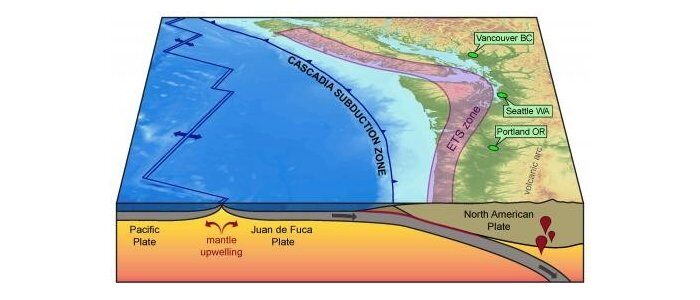
© (PSU News)Map of the Cascadia subduction zone.
We're learning more about earthquake triggers all the time, but there's also plenty still to find out about how these seismic shifts work. Now, geologists think they've identified a key mechanism behind some of the biggest earthquakes on the planet.
Megathrust earthquakes happen at subduction zones, where one tectonic plate is being pushed under another. They're particularly common around the Pacific and Indian Oceans, and they can also lead to gigantic tsunamis.A new study suggests that a gradual, slow-slip movement deep below the subduction zone could be key to understanding how megathrust earthquakes are triggered, and might potentially improve forecasting models to better predict them in the future.
These slow-slip events (SSEs) don't happen at every subduction zone, but they can affect how pressure builds up way down underground, the researchers say. Crucially, they move energy in different directions to megathrust earthquakes, and don't necessarily follow the movements of the plates themselves."Usually, when an earthquake occurs we find that the motion is in the direction opposite to how the plates have moved, accumulating that slip deficit," says geoscientist Kevin Furlong, from Pennsylvania State University.
"For these slow-slip earthquakes, the direction of movement is directly downward in the direction of gravity instead of in the plate motion directions."Using data from high-resolution GPS stations, Furlong and his colleagues analysed movements along
the Cascadia subduction zone (stretching from Vancouver Island in Canada to northern California) over several years.
A magnitude 9 earthquake happened in Cascadia in 1700, and since then SSEs have been occurring way down below the subduction zone, moving short distances at a slow rate. They're like "a swarm of events" the researchers say, and the pattern matches up with similar data logging from New Zealand. While SSEs occur many miles below the surface, their movements can affect both the timing and the behaviour of megathrust earthquakes, the team suggests. These smaller events occur every one or two years, but could trigger something much more serious."There are subduction zones that don't have these slow-slip events, so we don't have direct measurements of how the deeper part of the subducting plate is moving,"
says Furlong.
SSEs were first discovered by geologists around 20 years ago, and it's only recently that GPS instruments have been sensitive enough to capture their movements in detail - 35 kilometres (22 miles) underground in this case.The findings of the new study, described as "pretty unexpected" by the researchers, will help inform future earthquake models. It's possible, for example, that some of the stress from plate motion at subduction zones is released by SSEs deep underground.
What's more, knowing the direction of the forces that future earthquakes are going to release is crucial in planning for them. These natural disasters can be
very unpredictable, so any information that can be gathered ahead of time is invaluable.
"More fundamentally, we don't know what triggers the big earthquake in this situation," says geoscientist Kirsty McKenzie, from Pennsylvania State University. "Every time we add new data about the physics of the problem, it becomes an important component."
The research has been published in
Geochemistry, Geophysics, Geosystems.
Comment: See also: